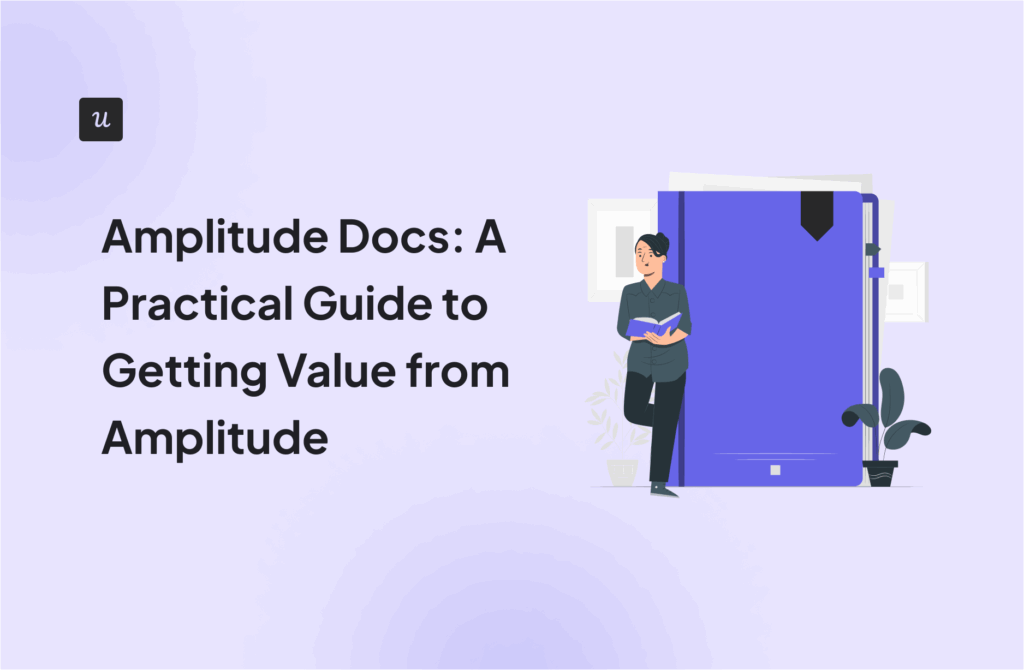
What are Amplitude integrations? How do they work?
These are 2 of the questions we answer in this article.
The main reason you should read it?
To learn about the 15 best integrations that the Amplitude product analytics platform offers its customers!
Let’s dive right in!
Try Userpilot Now
See Why 1,000+ Teams Choose Userpilot

What are Amplitude integrations?
Amplitude integrations are connections between Amplitude, a popular product analytics platform, and other software tools or data sources.
These integrations help businesses collect, manage, and analyze data across various systems.
For example, you can use them to sync data between Amplitude and your customer relationship management (CRM) system, product adoption tools, ad platforms, or data warehouses.
How can you integrate Amplitude with other tools?
There are a few ways to integrate Amplitude with other platforms:
- Built-in integrations: There are currently 138 no-code integrations available to Amplitude users. They’re easy to set up from its dashboard.
- APIs: To send data to and from Amplitude.
- SDKs: Available in different programming languages for web and mobile platforms, SDKs enable event logging directly from your apps.
- Webhooks: They allow you to send real-time data from Amplitude to a URL of your choice.
- Third-party connectors: You can use tools like Zapier to connect Amplitude with other tools for seamless data flow.
15 Amplitude integrations for connecting your existing customer data
With the basics covered, let’s look at 15 handy Amplitude integrations for your SaaS.
1. Userpilot
Userpilot is a product growth platform. It enables you to create in-app experiences to onboard new users and provide in-app guidance. It also offers feedback functionality and robust analytics features, including funnels, paths, and retention analysis.
Userpilot supports a one-way integration with Amplitude. Once enabled, it sends Userpilot data into your Amplitude account. In this way, you can analyze the performance of your in-app flows there.
Would you like a 2-way integration?
Amplitude offers its customers the ability to integrate with any tool, so just have a chat with their sales team.

2. Appcues
Appcues, like Userpilot, is also a digital adoption platform. You can use it to collect customer feedback and create onboarding flows or guide users with in-app messages.
But unlike Userpilot, it offers fairly limited analytics capabilities, so the integration with Amplitude comes in pretty handy.
It’s a 2-way integration, so you can seamlessly sync event data between the two apps.
For example, you can use Amplitude data to segment your users based on their in-app behavior and target them with in-app experiences. Or analyze user interactions with your flows using Amplitude’s advanced analytics features.

3. Segment
Segment is a customer data platform that allows you to integrate behavioral data from different sources. Thanks to that you can track customer behavior across all touchpoints in the customer journey and create unified user profiles.
Thanks to the 2-way Segment-Amplitude integration, you can gather, clean, and organize customer data and send it to Amplitude for in-depth analysis.
You can also import behavioral cohorts from Amplitude into Segment and use them to personalize marketing campaigns and product experiences based on user behavior or properties (e.g. user IDs).

4. Productboard
Productboard is a product management platform designed to help product teams prioritize features, understand customer needs, and align their work with the product vision.
It provides a centralized system where product managers can collect customer insights, organize feature requests, and visualize roadmaps.
The bi-directional integration with Amplitude enables product teams to make data-driven product development decisions.
For example, they can use behavioral cohorts in Amplitude to filter customer feedback, features, and notes, and create custom user impact scores. Or leverage customer and product data from multiple sources to measure feature performance.

5. Slack
Slack is a business communication app. Its features include instant messenger, voice and video calls, file sharing as well as channels and workspaces. It’s very popular among SaaS teams because it helps them reduce time spent in meetings, improve collaboration, and boost productivity.
Thanks to the integration, Amplitude users can easily share insights with other team members.
For example, users get Slack notifications when someone comments on their Amplitude content or starts making new analyses.
And when you paste a link to Amplitude Dashboard, Chart, or Notebook, a preview appears automatically in the chat.

6. Intercom
Intercom is a communication platform that helps businesses engage and support their customers. It supports live chat messaging, automated chatbots, a knowledge base, and help desk functionality.
The uni-directional integration allows Intercom users to import user segments from Amplitude for more personalized communication.
For instance, you could use it to announce features that are particularly relevant to their use cases, reengage churned users, or remove friction from the user journey.

7. Optimizely
Optimizely is a powerful platform that enables businesses to improve digital experience through experimentation and personalization. Businesses can use it to run A/B tests and tailor their website and mobile app content for better engagement and conversions.
The integration is bi-directional. This means Optimizely users can use Amplitude cohort data for targeted experimentation and then populate Amplitude user properties with data from experiments.
In this way, you can assess the impact of your experiments by segmenting users and analyzing the data in Amplitude reports.

8. Adobe Analytics
Adobe Analytics is a data analytics platform that helps businesses understand and analyze customer behavior across digital channels, platforms, and devices.
It’s best known for its advanced reporting capabilities which enable teams to make data-driven decisions. Teams use it mostly as an alternative to Google Analytics to optimize website and ad conversions.
Thanks to the 2-way integration, users can track customer behavior across all touchpoints for a unified user journey view and leverage Adobe’s reporting capabilities within Amplitude to extract actionable insights.

9. Airship
Airship is a digital customer engagement platform. It allows companies to target users with personalized messages across multiple channels, including email, SMS, in-app messages, and mobile notifications.
However, it lacks user behavior analytics and that’s where the integration with Amplitude comes in.
Users can leverage Amplitude analytics to track user behavior, segment them, and then engage with personalized messages for better engagement, retention, and conversions.

10. Qualtrics
Qualtrics is an experience management platform. It helps businesses collect and analyze data about their customers, employees, products, and brands.
You can use it to capture feedback and insights from various sources to improve decision-making and enhance overall experience.
The 2-way integration allows Qualtrics users to refine their email marketing campaigns using insights about user cohorts from Amplitude analytics and improve Amplitude segmentation by leveraging Qualtrics survey responses.

11. RevenueCat
RevenueCat is a platform designed to manage in-app subscriptions on various platforms (iOS, Android, and web).
It simplifies the process of implementing and managing in-app purchases. It enables companies to create custom subscription plans and set pricing models for different customer segments, and run experiments to streamline the pricing strategy.
The uni-directional subscription allows companies to import events from RevenuCat for more in-depth analysis.
This allows them to follow user cohorts throughout their customer journeys, analyze conversion paths leading to subscriptions, and attribute conversions to specific user actions.

12. SendGrid
SendGrid is an email platform that allows you to easily send and receive emails, including transactional emails, like password resets or receipts, marketing campaigns, and newsletters.
The SendGrid-Amplitude integration is bi-directional, so you can seamlessly sync data between the 2 platforms.
For example, it allows you to send event data from SendGrid to Amplitude for analysis. Thanks to that you can get granular insights into your email campaigns: open rates, CTR, and conversion rates. This helps you better understand user engagement and optimize them for better performance.
And as it’s with the other integrations, you can use user behavior data from Amplitude to create personalized emails and optimize campaigns for higher engagement and conversions.

13. Salesforce CRM
Salesforce CRM is a platform for managing customer relationships. It offers features like sales management, marketing automation, and customer support to streamline internal processes and enable teams from across the organization to gain a better understanding of user needs and behaviors.
The 2-way integration with Amplitude enables you to gain deeper insights into user interactions with your brand along the customer journey.
By integrating data from both platforms, you can create more detailed user profiles and segments, which enables you to engage and support them more effectively, for example, with marketing campaigns.

14. Toplyne
Toplyne is a platform that helps SaaS teams drive growth by efficiently converting free users into paid accounts.
In a nutshell, it uses customer data from multiple sources to segment and score leads to identify those that are most likely to convert to paid plans. You can then sync the data into your revenue tool stack, ready for your marketing and sales teams.
The integration with Amplitude allows users to score leads based on their behavior within web and mobile apps. In this way, you can easily identify your product-qualified leads (PQLs) ready for an upgrade.

15. Hotjar
Hotjar is a product experience optimization platform. It enables companies to analyze user interactions with their websites and apps via heatmaps and session recordings. It also offers survey functionality, so you can collect customer feedback for a more holistic view.
The 1-way integration with Amplitude allows Hotjar users to import Amplitude events data.
What’s the use of that?
- You can use them to trigger surveys, for example, to assess satisfaction with a specific feature that the user has just used.
- It enables you to filter session recordings and heatmaps by events. In this way, you can understand user activity leading to conversions or drop-offs.

Conclusion
Thanks to Amplitude integrations, you can analyze data from other tools in your tech stack using Amplitude’s advanced analytics. They also make it possible to use Amplitude data to inform your product development decisions, onboarding processes, and marketing campaigns.
Overall, the integrations allow you to gain a more complete understanding of customer behavior throughout their lifecycle and better satisfy user needs with personalized experiences and content.
If you’d like to learn more about the Userpilot-Amplitude integration, book the demo!







